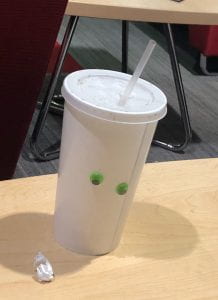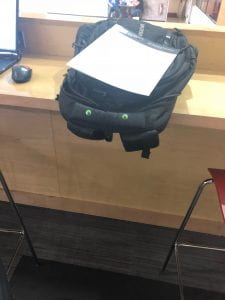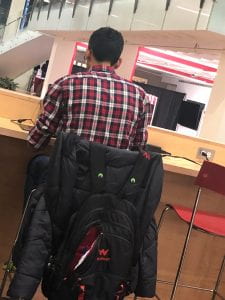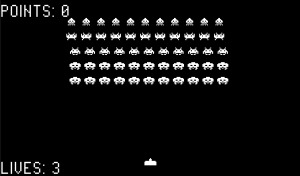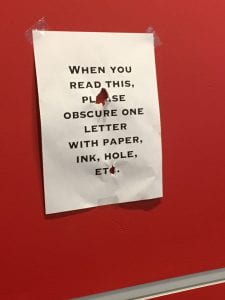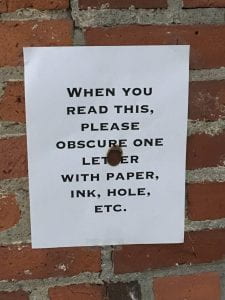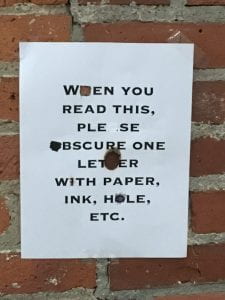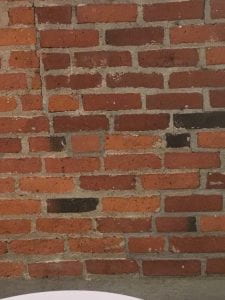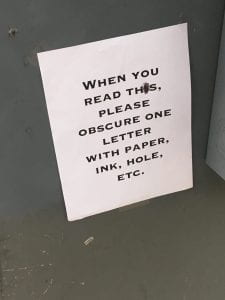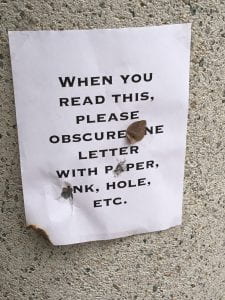THE FATHOM SOCIETY was an alternate reality game (ARG) that I ran in secret as the final project of my Experimental Game Design class. No one else in class, including the professor, knew who was running the game. I worked as the game’s solo designer, completing all of the design and writing for it, as well as executing it in secret.
My goal for The Fathom Society was to invite players to examine all the places in their daily lives where they could experience wonder. Throughout the game, players were encouraged to see the world a little differently, whether it was by viewing odd instruments in a local museum as extraterrestrial oddities, or by searching for “impossibilities” to document for one test. While I do not believe in the pseudoscience that formed the basis of The Fathom Society’s story, I believe that there is value in looking for inconsistencies and mysteries in one’s life, or “Little Cold Spots” and “holes in reality” as the game called them. An ARG, which blurs the line between reality and fiction, seemed like the perfect medium for exploration of these themes. When designing lore materials for the game, I worked hard to incorporate real world elements (Tom Shanks’ Cold Spot research study, and the spiritualist Adam Apollo’s pseudoscientific web database), while flavoring them with enough game connections that players could never be certain of their reality.
My primary influence when designing The Fathom Society was a similar (though far longer) ARG called “The Jejune Institute,” which my Experimental Game Design class studied prior to this project. The structure of The Fathom Society was modeled closely on The Jejune Institute, as both incorporate secret societies, pseudoscience, enigmatic characters, and figures that blur the line between real and fictional (Adam Apollo in The Fathom Society, and Eva in The Jejune Institute).
I hope that the players of The Fathom Society had as much fun playing it as I had running it, because it was a complete blast to write.
FULL DOCUMENTATION:
In the middle of Experimental Game Design class on a dreary November afternoon, a Bluetooth speaker hidden behind the projector interrupted a playtest with a cryptic message:
Are you listening?
Hello, friends.
You have been selected. Whether for your technological acumen, or your creative brilliance, or your belief in a higher power, you are all here together because you ought to be. In a world without magic, there can be no coincidences. If you believe in nothing, believe in yourself.
If you think you can fathom the truth, stay tuned. You will be notified shortly about next steps.
Keep this speaker safe. Keep it charged. Keep it on during class.
Let’s break the world together.
Thus began the Fathom Society alternate-reality game, my secret final project for the class. No one else in the class, including the professor, would know who designed the ARG until its end.
Within minutes, every student in class (and the professor) received an email from an anonymous address. The email contained a PDF of enciphered text entitled “YLUQ MDQRS SORS,” as well as the following image:
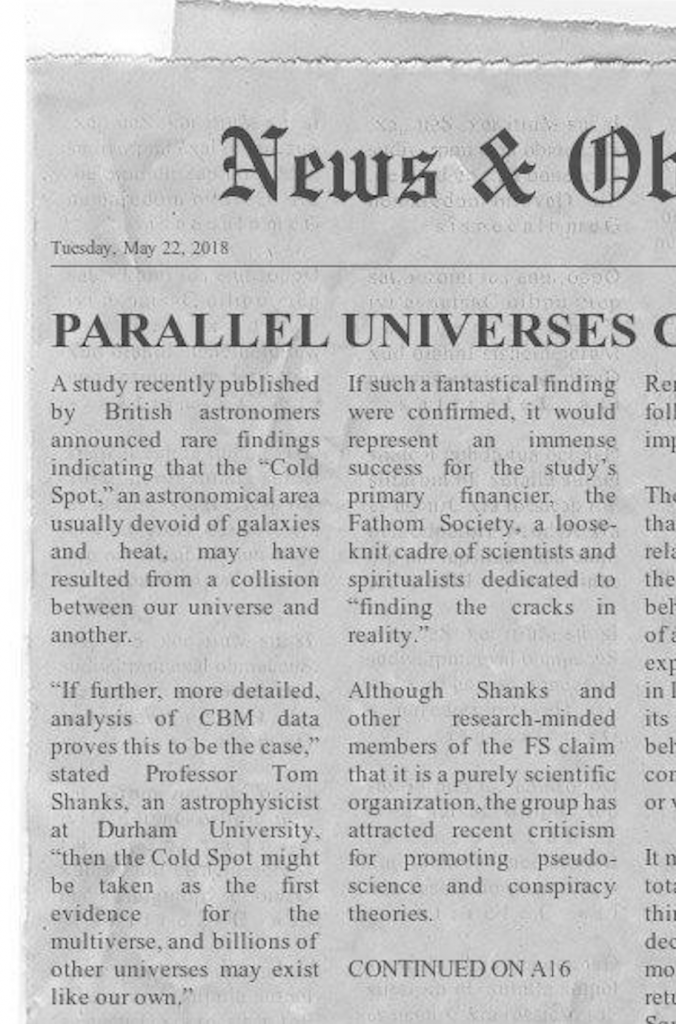
Students quickly decoded the ciphered PDF, which contained the following message:
YOUR FIRST TEST
Hello, friends. I am glad that you have made it here.
My name is Miriam.
I represent the Fathom Society, an underground network of scholars and spiritualists dedicated to shattering the chains that bind humankind to one reality and one way of being. We are the ones who see the light shining from under the door. We are the ones looking for a key that fits in the lock. We are the ones who shatter mirrors to reach the other side.
Allow me to explain. This is your world:
YOUR SECOND TEST: Print out this map, one for everyone. Scribble on it. Rename it. Sketch a new kingdom over that flat and fragile sheet. Draw yourself on it. Walk around. Or burn the map, but only your own. You must do at least one of these things to understand.
That, then, is our goal; to release unto mankind an ultimate creative power. To make us once again the masters of our reality, just as we were when we dreamed demons and heroes into creation.
All of you are candidates for initiation. If you wish to, you may step down from this revelation at any time. Be wary, though: those who doff the seeker’s mantel might never don it again.
If you do desire to peer beyond, meet me at (fifty six – thirty five) x (forty one – twenty nine). Come as a group. Bring the speaker.
A thousand futures await.
When students drew lines across the map from the number 56 to the number thirty-five, and from the number forty-one to the number twenty-nine, they almost immediately received another email from “Miriam:”
When you find the meeting point, send me the name of the Sentinel there.
When students travelled to the point where the lines intersected, they found a sculpture entitled “Pharah,” and when this name was emailed to Miriam, the students received an email detailing the next test:
Hello, friends.
Congratulations on making it here. Many would have despaired at simple ciphers; many more would have dismissed the holes in the world outright. But here you are, as I knew you would be. You, too, seek the Little Cold Spots.
Then, with deduction and belief quantified, let us begin YOUR THIRD TEST.
I need you each to find something impossible. Find it, document it in whatever way is fitting to its form, and send that documentation to me. You have three days to complete this test.
Only the worthiest shall proceed. I look forward to your discoveries with the greatest of anticipation.
The Universe is alive.
In addition, the email contained a PDF copy of a web page discussing the debunked scientific theory of luminiferous aether. Research into this article and its author (a spiritualist named Adam Apollo) revealed a deep, interconnected database of pseudoscience and mysticism.
Over the next two days, students emailed Miriam a wide array of “impossibilities,” from attempts to replicate urban legends to videos supposedly demonstrating alchemical transmutations. At their next class after completing this task, the speaker delivered another message:
Very good, my friends. You have discovered wonders already. Each of your impossibilities is a hole, a logical fallacy, a Little Cold Spot where another universe of possibilities touches our own.
For your next test, visit your library and search the science section for unity, mentality, and then emotionality. Once again, that is unity, mentality, and then emotionality. Apollo’s sacred knowledge will guide your way.
At about this time, a user named “Miriam” appeared in the class Discord server and began dropping cryptic hints about the puzzles ahead.
Intrepid students soon located Adam Apollo’s aforementioned website, and the “Sacred Knowledge Database” there. In the numerology section of the website, they discovered numbers that supposedly corresponded to unity, mentality, and emotionality: 1, 7, and 6. At catalog number 176 in the science section of the campus library, they discovered a folder containing a paper copy of Apollo’s luminiferous aether article, a magnifying glass on a chain taped into a pentagram, and a flash drive:
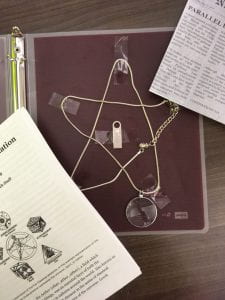
The flash drive contained links to two “SCP Foundation” articles about anomalous musical instruments (SCP- 926 and SCP- 2458), as well as a PDF containing the following text:
Consider me impressed, my friends. That last puzzle was a tricky one.
I have left you a box in a locker in your Ryder Hall. The box contains the deepest secrets of the Fathom Society. You have nearly earned them. You have met Tom Shanks, the scientist, and Adam Apollo, the believer. You have broken ciphers and sought real truth. However, one final test remains before you may open the box.
It has recently come to our attention that a local museum is currently displaying several extraterrestrial and extradimensional instruments, erroneously labeled as Earth artifacts. These relics include a rare Bulbous Clarinet, a Gurunsian end-blown flute from a parallel universe, and a priceless ophicleide from Aldebaran. This presents a marvelous opportunity for you to view miracles yourself.
I especially urge you to closely examine:
- The trumpets of horn and bone
And then:
- The slide trumpet and the union pipes
- The twisted cornet and the silvershells
- The ophicleide
The fractures widen, my friends.
Students journeyed to the nearby Museum of Fine art, where they found the listed instrument in an exhibit. When the reference numbers for these instruments were pieced together, they created the following string of numbers:
22 17 23 5
In locker 22 (combination 17-23-5) in Ryder Hall on campus, students discovered a small metal box and the instructions:
Open only during class. Have the speaker ready.
The next day, during class, the students cracked open the box to reveal print-outs of the impossibilities they submitted, a collection of items from their final projects that had been surreptitiously spirited away, and a collection of game pieces, tarot cards, and small crystals. The speaker played the following message:
You have done well, my friends. You have done so very well. You have witnessed the cracks in the world, and you have come out stronger. You have believed me, and you have questioned me, and both of those things are good.
But now, my friends, I have a confession to make.
I am not real. I am only a voice on the radio waves. Adam Apollo is not real. Neither is Tom Shanks. Perhaps we were real once, but we are gone now, my friends. We have fallen away through the cracks in the world. Through the Little Cold Spots.
There is no Fathom Society.
Or, at least, there wasn’t until now.
Look in the box, friends. Look at the things you have made. Fragments of wonder and truth and new realities. Each of your games and each of your stories is a Cold Spot in miniature, a place where another world touches our own. These scraps of paper are hammers, my friends, and you are the masons, chipping away at this old dusty world, fracturing it, and rebuilding it better.
You, my dear, dear friends, are the founding members of the Fathom Society.
Go break the world for me.
And so the Fathom Society was born.


